Late-summer salmon fishing options continue to blossom all across the Pacific Northwest and success remains decent in some places Leave a reply
By Mark Yuasa
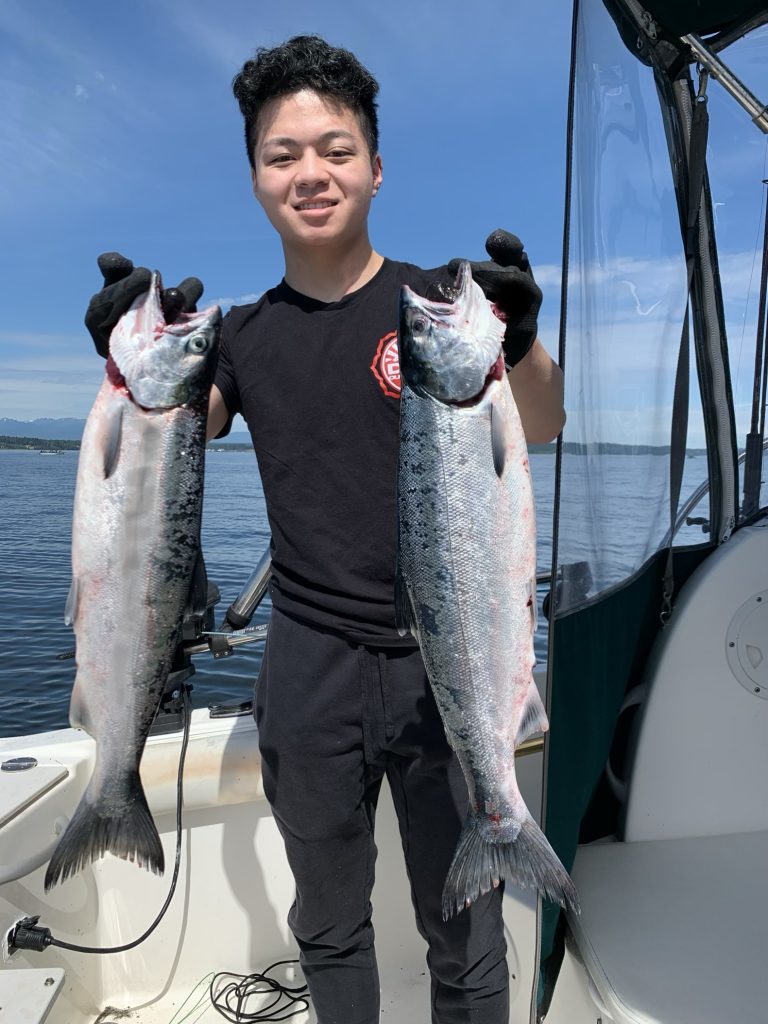
This is my favorite and most busy time of the year to wet a line with a multitude of salmon species spread throughout the Columbia River, the eastern Strait of Juan de Fuca clear into Puget Sound and other fishing holes around the Pacific Northwest.
Many are making plans to hit the mouth of the mighty Columbia River as an estimated fall chinook forecast of 420,450 (379,769 was actual return and 349,600 was forecast in 2019) plus a modest coho return of 140,190 (212,333 and 611,300) will be streaming into the Buoy 10 area over the next few weeks.
The king fishing at Buoy 10 will be a short but hopefully a very sweet 14-day season at this legendary late-summer/early-fall location where anglers converge on this 20-mile stretch of the river from Ilwaco, Chinook and Astoria.
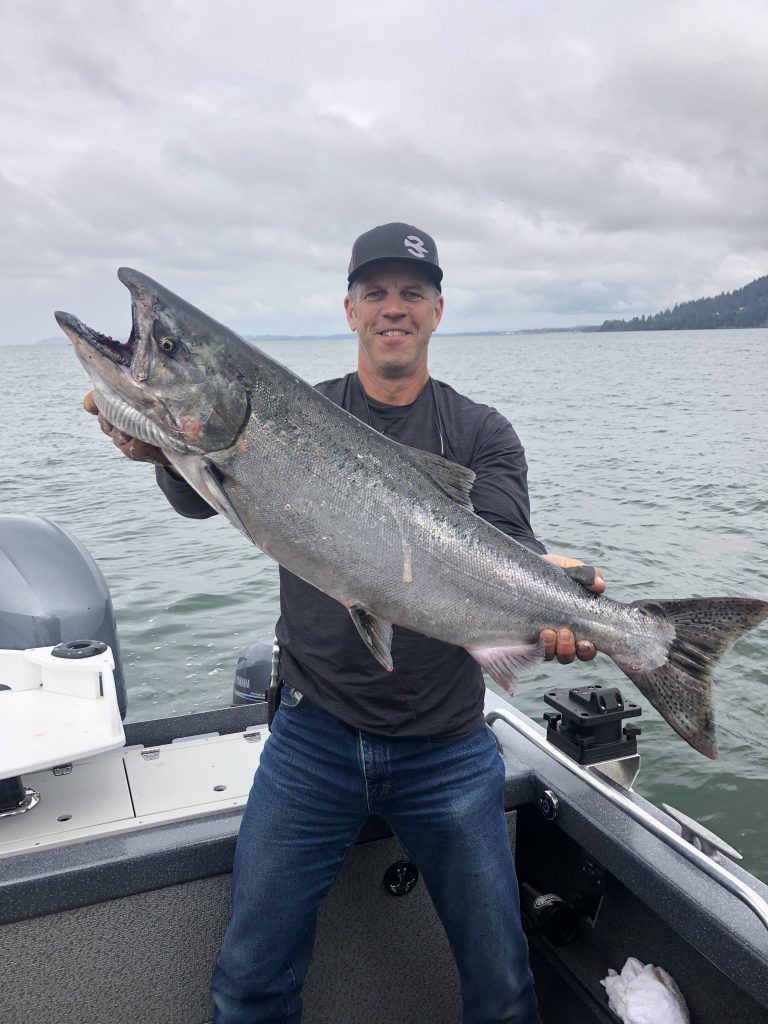
Tom Anderson, owner of Burnewiin in Hood River, OR. holds up a nice king caught in August of 2019 near the Astoria-Megler Bridge on the Lower Columbia River.
The fishing season is open from Aug. 14-27 with a daily limit of one salmon (chinook minimum size is 24 inches and a hatchery coho minimum size of 16 inches). Then from Aug. 28 through Sept. 22 there is a one hatchery coho only daily limit. Another brief window from Sept. 23-30 will allow anglers to keep one chinook or hatchery coho daily.
In the early morning on a flood tide, those coming out of Ilwaco should make a first drop of the lines along the Wing Walls.
The Desdemona Sands area – a flat sandy bar exposed at low tide – is a mid- to late-flood tide show as chinook migrate along the drop-offs on both sides of the channel.
The buoy line just off the town of Astoria where huge ocean-bound freightliners anchor up just above the Astoria-Megler Bridge is a decent location during an incoming tide as salmon follow the currents upstream.
On the Washington side just above the bridge are three underwater channels where migrating kings will move up and down depending on the tide. Other spots are the Church Hole off Fort Columbia State Park; from the Fort Stevens State Park on the Oregon side west toward Hammond.
About 300-plus miles upstream, the Columbia River mainstem continues to provide fair to good action for a mix of summer kings and sockeye in the Pateros/Brewster area of north-central Washington.
“It has been lights out (for sockeye and a few hatchery kings),” said Aaron Peterson, owner of Peterson’s Northwest Guide Service. “Limits in a half-an-hour.”
The daily sockeye limit on the Columbia River mainstem above Priest Rapids Dam is now six salmon and up to two may be adult hatchery chinook and up to four may be sockeye. Minimum size 12 inches. Anglers must release wild adult chinook and coho.
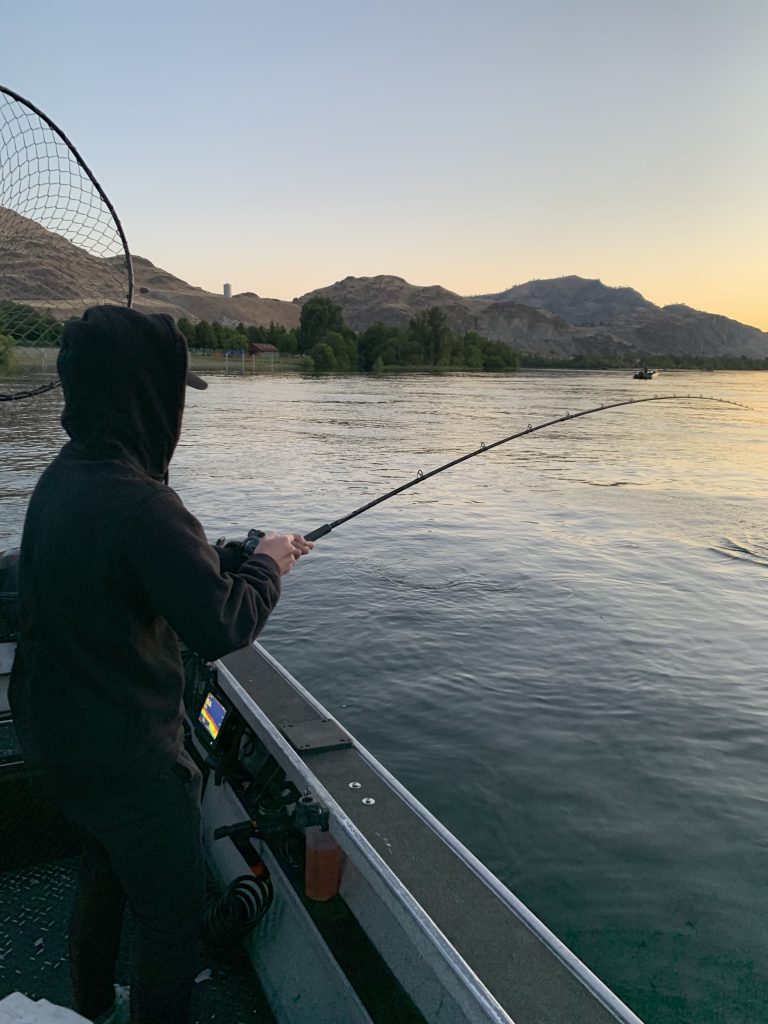
Lake Wenatchee opened today (Aug. 3) for the first time since 2017, and should be productive as 34,884 were counted at Tumwater Dam through July 28.
“We’re expecting a good sockeye return of 35,000 to 40,000 (39,400 is the forecast) to Lake Wenatchee, which leaves about 8,000 to 15,000 for folks to catch,” said Chad Jackson, a WDFW biologist in Ephrata.
The daily limit at the beautiful Chelan County lake is four sockeye per angler with a minimum size of 12 inches. Selective gear rules (up to three single-point barbless hooks per line, no bait or scent allowed, and knotless nets required) are in effect.
Anglers may fish with two poles if they possess a valid two-pole endorsement. A night closure will be in effect. Legal angling hours are one hour before official sunrise to one hour after official sunset.
Bull trout, steelhead, and chinook salmon must be released unharmed without removing the fish from the water.
What’s biting elsewhere
Heading to the coast, the Willapa Bay hatchery king fishery opened this month and has a two adult salmon daily limit (released wild chinook). A forecast of 31,185 chinook should create some good times for anglers inside the bay’s deep channel that is dotted with red and green channel markers numbered from 2 to 27 (I like to fish markers 7 to 13). The markers start in the middle of the bay and run all the way to the Willapa River mouth, and it is here where the salmon stage before migrating into the Willapa River. Fish it on the flood tide to avoid foiling up your gear on eel grass and seaweed.
Just up the coast, the Westport Boat Basin docks open for fishing on Aug. 16 and the coho returning to local net pens offer some fair action through September.
In Puget Sound, the hatchery king fishery continues to be a head scratcher in most of northern, central and south-central Puget Sound although catches have ramped up over the weekend at places like the entrance to Admiralty Inlet.
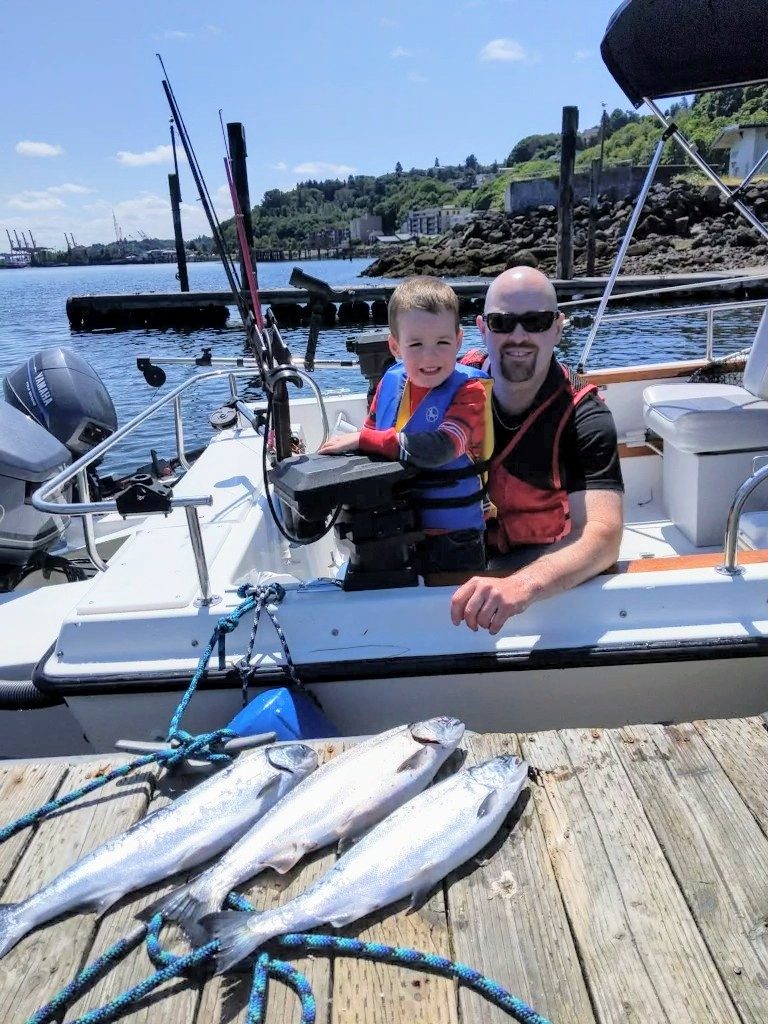
At this point WDFW decided they won’t raise the daily hatchery chinook catch limit from one to two because all it takes is for success and effort to skyrocket leading to emergency closures, which is something nobody wants at this point.
“Time on the water is more the highest priority,” said Tom Nelson, the host of 710 ESPN The Outdoor Line and a WDFW Puget Sound sport fishing advisory board member.
Baitfish (herring and candlefish) remain abundant throughout Puget Sound from Midchannel Bank south to Olympia so that is great news. Even better is more chinook have appeared in catches of late at Midchannel Bank off Port Townsend and Port Angeles so hopefully we’ll see a push of fish entering into Puget Sound very soon.
Try Kingston, Jeff Head, Edmonds oil dock, Richmond Beach, West Point south of Shilshole Bay, Point Monroe, Yeomalt Point and Skiff Point off Bainbridge Island’s east side, Lincoln Park off West Seattle south to Brace Point, north side of Vashon Island near ferry landing and Dolphin Point as well as Southworth.
Other good southern region options for kings are the Clay Banks off Point Defiance Park, Point Evans, Point Dalco off Vashon Island, entrance to Gig Harbor, Gibson Point, Point Fosdick, Fox Point in Hale Passage, northwest corner at the Sand Spit, Toy Point and the Concrete Dock Fox Island Fishing Pier. These are all late-summer bloomers as the bulk of migrating South Sound hatchery chinook stage in those locations before heading to places like the Nisqually River and other river systems.
The inner-Elliott Bay chinook three-day fishery comes to an end today (Aug. 3) at noon and while there were some kings caught off the east channel waterway, in front of Todd’s Shipyard and off Salty’s Restaurant it wasn’t decent by any means. The possibility of reopening the bay may or may not happen and we should know more by the middle of this week. Stay tuned…
Sekiu in the Strait of Juan de Fuca (Area 5, closed for chinook retention but open for hatchery coho) the total legal-size encounter is 6,662 hatchery chinook of a catch guideline of 7,032 which puts the area at 95 percent through July 26. San Juan Islands (Area 7, closed for chinook retention but open for coho) harvest estimate is 1,317, which is 84 percent of a catch quota of 1,562 through July 26. Northern Puget Sound (Area 9) harvest estimate is 1,702, which is 26 percent of a catch quota of 6,542 through July 26. Central Puget Sound (Area 10) harvest estimate is 241, which is 6 percent of a catch quota of 4,159 through July 26. South central Puget Sound (Area 11) harvest estimate is 562, which is 13 percent of a catch quota of 4,196 through July 26.
Shorebound anglers have opportunities to catch kings at Edmonds Pier, Des Moines Pier, Les Davis Pier and the Seacrest Pier in West Seattle. FYI: The Redondo Pier is closed for maintenance work and likely won’t reopen for some time. We don’t talk much about Hood Canal, but it has been producing some hatchery kings south of Ayock Point. Quilcene Bay is open through Aug. 31 for a coho only fishery.
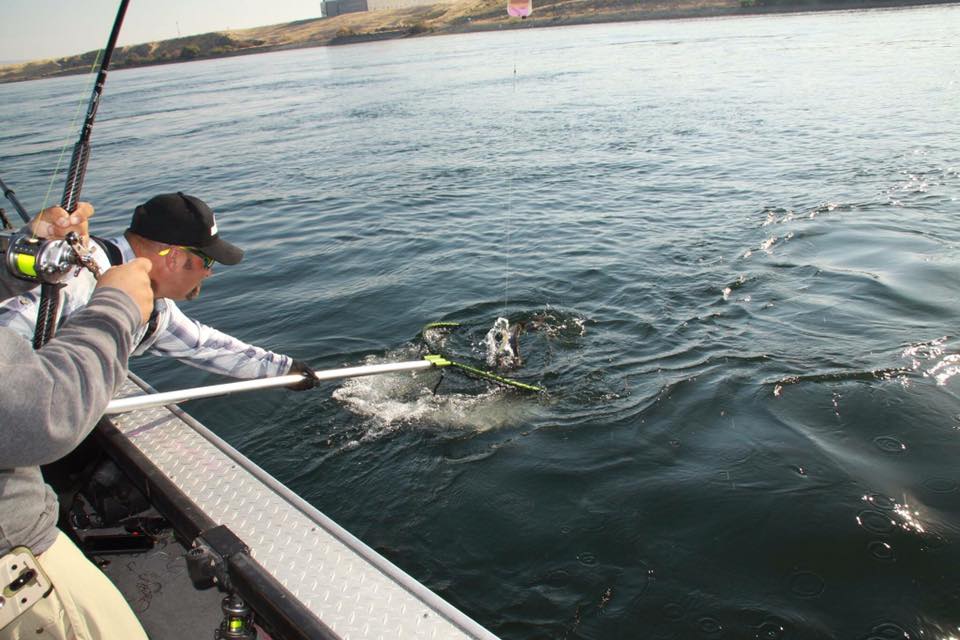
There are some terminal chinook fisheries like the Tulalip bubble fishery and Sinclair Inlet that produce action in August. Also, don’t forget to bring the Dungeness crab traps on days and locations that are open for fishing.
Before heading out the door, check the WDFW website at https://wdfw.wa.gov/ to see what is open or closed and what you can or can’t keep, plus any possible emergency closures this month.
Coastal halibut fisheries set to begin Aug. 6
Marine Areas 1 (Ilwaco/Chinook) and 2 (Westport) All-depth: Opens Aug. 6. Then beginning Aug. 13 open Thursdays and Sundays only, through Sept. 30 or until quota is achieved. If the number of anglers participating and the number of halibut caught is lower than expected, additional days may be added. Proposed additional days are Aug. 28, Sept. 4 and Sept. 11.
When fishing in the deep-water lingcod closed area in Area 2, anglers can keep lingcod on days open to all depth halibut fishing. In Area 1, during the all depth fishery, anglers can retain flatfish, sablefish, Pacific cod, and lingcod north of the Washington-Oregon border when halibut are on board. Area 1 nearshore: Open Aug. 10 on Mondays, Tuesdays and Wednesdays only until the nearshore quota has been taken. Bottomfish may be retained with halibut on board in the nearshore area only.
Marine Areas 3 (La Push) and 4 (Neah Bay): Opens Aug. 6 on Thursdays, Fridays and Saturdays only through Sept. 30 or until quota is achieved. Neah Bay on Makah Reservation and La Push on Quileute Reservation are closed to the public therefore access is allowed from other ports like Sekiu and Westport.
Puget Sound halibut season (Marine Areas 5 to 10): Opens Aug. 6 on Thursdays, Fridays and Saturdays only through Sept. 30 or until quota is achieved.
In all marine areas there is a one-fish daily catch limit with no minimum size restriction. Anglers may possess a maximum of two halibut in any form while in the field and must record their catch on a WDFW halibut catch record card. There is an annual limit of four halibut.

